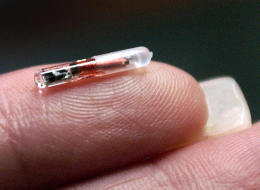Specifically, small, RFID chips (Radio Frequency Identifier) implanted below the skin of the animal allow for various authorities to electronically read owner information about the pet. Instead of hoping to find a tag, they can scan the cat or dog's spinal column, usually near its neck, with an RFID scanning device.
These microchips, of course, do not come with a dedicated power source. Instead, the RFID scanner is the power source, when it is scanning. This principle operates in a similar fashion to other wireless charging devices, as seen in some cell phones and sonic toothbrushes (to name a few devices). The field generated by the scanner provides just enough power to the microchip for it to send a very short range radio signal back to the scanner, passing off its data to the user.
The microchips are coated in a special type of glass which does not harm the animal, and is resistant to infection if properly injected. As the very small injection heals, tissues from the pet's body will form around the device, which is about the size of a grain of rice, and hold it in place. All in all, it is a very small price to pay to ensure your loved pet can always find you. If interested, consult your local veterinarian or humane society.
Tell us your thoughts on this in our Forum




